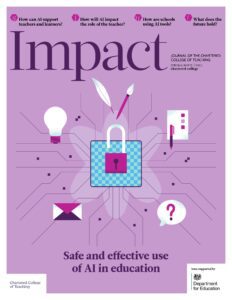AI spy: Tracking the tools that teachers use

KAREN WESPIESER, TEACHER TAPP, UK
Since 2020, Teacher Tapp has been checking how teachers are adopting artificial intelligence (AI) tools. In November 2024, we asked teachers:
What AI-powered tools or technologies (if any) have you used or experimented with in your teaching practice?
The data featured in this Teacher Tapp research has been gathered from our daily surveys of over 11,000 teachers. We have aimed to represent the teaching population overall, by:
- ‘Reweighting’ the sample each day. This means statistically rebalancing the results, using the Department for EducationThe ministerial department responsible for children’s services and education in England workforce census (DfEDepartment for Education - a ministerial department responsible for children’s services and education in England, 2024), to ensure that there is the right proportion of teachers by gender, age, phase, job seniority and region.
- Checking the results from key questions against other national surveys. This shows that we get very similar results to other ‘random sample’ surveys (see Jerrim, 2023).
What do teachers use AI tools for?
- Generating model texts: Teachers use AI tools to create model texts (also known as ‘What A Good One Looks Like’ or WAGOLL) that exemplify writing features, vocabulary and text types for students to analyse and emulate.
- Writing reports: AI tools have been used by teachers in writing various types of report, including student reports, professional development reports, governor reports and subject reports. They say that it helps to generate comments, phrases and entire paragraphs, saving teachers time and effort.
- Creating resources: Teachers use AI tools to create resources such as worksheets and comprehension questions based on various sources, including texts, videos and YouTube transcripts.
- Lesson planning and curriculum development: AI tools have been used by teachers to assist in generating lesson plan ideas, sequencing lessons, creating lesson overviews and outlining schemes of work. It has helped teachers to explore new topics and organise their teaching content more effectively.
- Writing letters and emails: Teachers use AI tools to help to draft professional communication for parents, staff and stakeholders. Teachers have used it to assist with wording sensitive topics, creating templates and ensuring clear and accessible language.
- Generating quiz questions and multiple-choice questions: Teachers have used AI tools to create quizzes and multiple-choice questions for a variety of purposes, including retrieval practice, formative assessment and homework assignments. They use AI tools to generate questions based on specific texts, videos or topics, and to provide answer keys and mark schemesCriteria used for assessing pieces of work in relation to particular grades.
- Simplifying and differentiating text: Teachers adjust the reading age and complexity of texts to make them more accessible for students with varying reading abilities and learning needs. Teachers report that this can be particularly helpful for students with English as an additional language, and those with special educational needs and disabilities.
- Creating revision resources: Teachers in secondary schools use AI tools to generate revision materials, such as summaries, keyword lists, flash cards and quizzes, helping students to prepare for exams and assessments.
- Providing model answers and essay structures: Secondary school teachers have used AI tools to generate model answers and essay structures for various exam boards and subjects, allowing students to see examples of high-quality work and understand the expectations for assessments.
- Generating creative content and stimuli: Teachers use AI tools to write poems, stories and scripts for various purposes, such as providing examples of different writing styles and creating classroom activities.
Generic AI tools vs education-specific tools
Launched in 2022, ChatGPT quickly amassed millions of users. We tracked teacher adoption of ChatGPT across three months in spring 2023, and saw a significant growth in awareness of the product during this relatively short period, as well as increasing usage. Among teachers using ChatGPT, around half were using it to help with their school work.
Usage of education-specific AI products remains low; fewer than three per cent of teachers had used more than one of the tools that we tested and only 24 per cent of teachers had used at least one of them in the past six months. This compares to 34 per cent of teachers having used a generic AI tool (e.g. ChatGPT) in the past week. The most common functionalities named by teachers were lesson planning (included in 15 of the 28 tools), resource creation (12) and quiz generation (11). There is also a strong degree of overlap between these functions, with 22 of the 28 products including at least two functions. Other popular functions include assessment (10), writing reports/communicating with parents (nine) and differentiation (nine).
New tools
Nineteen of the 28 AI tools identified by teachers in November came from companies established in 2023, reflecting a recent surge in educational technology development.
TeachMateAI, established in 2023, has some of the highest awareness, usage and recommendation scores of any of the AI tools we looked at.
Among the more established companies, there is a pretty even split between tools that offered solutions using AI before the widespread commercial awareness caused by the launch of ChatGPT (e.g. Quizzizz) and those from existing tools that have built a new AI feature (e.g. KeyGPT or Aila from Oak National Academy).
Over half of teachers had not used any of the AI tools that we tested. Generally, the usage of education AI tools was higher among teachers who already used generic AI products, such as ChatGPT. In other words, teachers who use generic AI products are more likely to use education-specific AI products than their colleagues.
Supporting teachers
As AI use becomes more widespread education, AI advocates and school and trust leaders have an opportunity to guide and support teachers at all stages of familiarity and adoption. Here are four practical strategies for engaging different groups of teachers.
1. Teachers who are new to AI
These teachers may have heard of AI but lack a clear understanding of its relevance to education.
- Raise awareness through simple messaging: Use research evidence to explain how AI tools can save time, reduce workload or improve teaching outcomes.
- Showcase real-world examples: Provide case studies of how other teachers use AI in similar contexts.
2. Teachers who haven’t used AI for their work
These teachers may understand AI conceptually but feel unsure about how to incorporate it into their practice.
- Offer practical resources: Create downloadable templates or step-by-step guides on specific uses of AI, such as generating lesson plans or creating differentiated resources. Make this as specific as possible to the year groups and subjects that they are teaching.
- Provide hands-on experiences: Run interactive workshops where teachers can try out AI tools in a supportive environment, with clear demonstrations of their use and benefits. These can take place online at the end of the school day, with teachers using free AI tools or your own products.
- Address common concerns: Proactively tackle barriers such as time constraints, lack of confidence or worries about accuracy, by highlighting how AI can complement – and not replace – teachers’ expertise. Provide courses on responsible AI use in education. Emphasise ethical considerations, such as data privacy and avoiding bias.
3. Teachers who are casual users of AI
This group uses generic AI tools, such as ChatGPT, but hasn’t explored specialised educational AI products.
- Explain additional benefits: Emphasise how education-specific AI tools address privacy concerns, align with curriculum requirements or include features tailored to teachers’ needs.
- Provide quick comparisons: Create side-by-side comparisons showing how education-specific tools can be more efficient, secure or relevant than generic tools.
4. Teachers who are regular users of AI
These teachers have already integrated AI into their work but may not yet use education-specific tools.
- Focus on advanced features: Highlight how education-specific tools go beyond the basics, such as generating curriculum-aligned assessments or providing student-specific interventions.
- Promote communities of practice: Build online or in-person communities where experienced users can share tips, resources and success stories.
The examples of AI use and specific tools in this article are for context only. They do not imply endorsement or recommendation of any particular tool or approach by the Department for Education or the Chartered College of Teaching and any views stated are those of the individual. Any use of AI also needs to be carefully planned, and what is appropriate in one setting may not be elsewhere. You should always follow the DfE’s Generative AI In Education policy position and product safety expectations in addition to aligning any AI use with the DfE’s latest Keeping Children Safe in Education guidance. You can also find teacher and leader toolkits on gov.uk .
- Department for Education (DfE) (2024) School workforce census 2024. Available at: https://assets.publishing.service.gov.uk/media/662a3d0d690acb1c0ba7e5de/2024_School_Workforce_Census_Specification.pdf (accessed 14 February 2025).
- Jerrim J (2023) Teacher surveys: The pros and cons of random probability surveys versus teacher panels. Review of Education 11(3): e3428.










